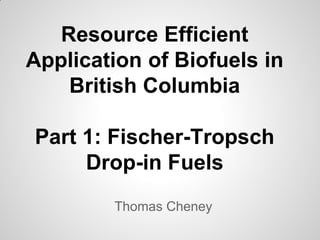
Resource efficient bioenergy for BC
- 1. Resource Efficient Application of Biofuels in British Columbia Part 1: Fischer-Tropsch Drop-in Fuels Thomas Cheney
- 2. Bioenergy is limited BCs Bioenergy Resources are limited Efficient utilization is required
- 3. Using bioenergy right The Right Process • Energy Efficiency • Cost effective The Right Fuel • Allows use of non-food • Compatible with the infrastructure feedstock • Scalable • Cost effective • Clean-burning • Distribution • Range Co-Benefits: Carbon Capture, improved soil
- 4. Why Resource Efficiency Matters BC Biomass resources are limited • Equivalent to 40% of BC fossil fuel use • Mountain Pine Bettle fibre supply spike • 300 PJ sustainable potential
- 5. Not all biofuels are created equal • Some biofuels produce far more fuelhectare than others
- 7. BC Energy Use breakdown Sector PJ PJ Biomass can meet 25- Transportation 404 30% of Provincial Industry 362 energy demand Agriculture 18 Residential 136 Comm., Instit. & Public Admin 105 Power Generation 35 Total 1060 Biomass Capacity 250-300
- 8. An American Perspective • Biomass is not a panacea “If all biomass were used in CBTL-CCS systems designed to maximize liquids output, 5.9 million bbl/day transport fuels could be produced. ≈ U.S. domestic crude oil production. ≈ ½ of U.S. oil imports” This assumes that the process with driven with coal with biomass providing the carbon atoms!
- 9. BC’s GHG emision Of total Marine 3.96% Off-Road 5.40% Rail 0.72% Air 2.52% Passenger Vehicles 14.04% Heavy Duty Vehicle 9.36%
- 10. BC Transportation • 300 Petajoules of energy use • Assuming conversion efficiency rate of 40%, 120 PJ of fuel could be realized. This however leave very limited bioenergy resources available for sectors other than transportation fuel
- 11. Electric vs. Biofuel Vehicles empr.gov.bc.ca • Vast electric • Limited liquid fuel supplies supplies • Limited Range • Long range with simple refuelling
- 12. We need both Apply the right technology in the right place The “Algaeus” biofuel plug-in • Electricity should be seen as the dominant prime mover in B.C • Biofuels hydrogen for range extension
- 13. How do we get biofuels? • Thermochemical Pathway o Fischer-Troposch o Di-Methyl ether (DME) and Methanol Green Gasoline o Biomass Synthetic Natural Gas o Hydrogen • Biochemical Pathways o Ethanol o Others based on proprietary organisms (LanzaTech)
- 14. Thermochemical Process can produce many energy products
- 15. Thermochemical Fuel Cycles • Gasification, Gas Cleaning, Chemical
- 16. One Option is FT-Biofuels CHOREN Biofuels Plant in Germany
- 17. FT FUEL • CO + H 2 CH2 + H2O • Used for coal since 1930s
- 18. Biomass-Based FTFuels • Clean syngas is essential • Entrianed flow gasifiers are considered to be the most mature technology • Biomass feeding is a challenge • Similar technologies used in Coal to Liquids
- 19. FT Advantages • 40% efficiency • Drop-in fuel! • Established for coal and gas to liquids • Biomass specific technology pre- Coal to Liquids Plant in South Africa commercial http://s2.hubimg.com/u/5090925_f260.jpg
- 20. FT Compared to the Cellulosic ethanol http://mitei.mit.edu/system/files/kreutz-fischer-tropsch.pdf <2.5 units of biomass are required per unit of fuel.
- 21. Economics of FT b Competitive with oil at $115 per barrel gasoline withoug carbon price http://www1.eere.energy.gov/hydrogenandfuelcells/pdfs/liquid_trans_tech.pdf
- 22. Biomass injection Particular challenges to BtL o Use of coal based systems have energy use challenges biomass grinding to 100 um uses 8% of energy in biomass o Coal-based systems use a lock hopper o Biomass based systems using screw injection leads to greater energy efficiency Less pressurisation needed Less dilution
- 23. Piston Feeding of Biomass • Biomass specific feeding system appear best rather than the systems adapted for coal. o Greater efficiency o Van der Drift et al. 2004 covers these issues in detail o “ENTRAINED FLOW GASIFICATION OF BIOMASS: Ash behaviour, feeding issues, and system analyses”
- 24. Van der Drift Syngas Preparation Preliminary gasification (option D) offers highest efficiency approach.
- 25. Choren • Low temperature gasification followed by high- temperature gasification to clean gas. • Pre-treatment low-temperature gasification to resolve challenges with biomass gasification of woody biomass
- 26. Solar Assisted Fuels • Uses solar energy to drive endothermic reaction for biofuels. • Hydrogen created from solar energy avoiding loss of carbon through reverse gas shift Hertwich, E. G. and Zhang, X (2010) “Concentrating-Solar biomass gasification process for a 3rd generation biofuel
- 27. Solar fuels • Solar cogeneration for electrolysis and gasification heat to increase process carbon efficiency
- 28. Cost Analysis for solar fuel analysis • 7.5$ per GJ of fuel produced (2001 $) Input costs $2.5 per GJ • 60% Less land total • 67% less land for biofuels • Assumes a $100 /tC Indicators Solar- Bomass Coal Biomass Fuel Fuel Productivity 121.0 39.9 62.2 (kg fuel/100 kg resource) Cost ($2001/GJ) $7.5 $8.9 $10.8 Efficiency 60.9% 42.0% 36.5%
- 29. Coal Biomass FT Fuels • Coal with carbon capture and storage can leverage the biomass 1.5 units of coal + 1 unit biomass = 1 unit fuel + 1.5 units sequestered CO2 565 liters gasoline equivalent with coal +CCS versus 25l lge! http://mitei.mit.edu/system/files/kreutz-fischer-tropsch.pdf
- 30. Remember This: • Coal with CCS allows for low- mitigation cost very low CO2 fuels
- 31. Carbon-Neutral Coal Based biofuel • 38% biomass + CCS leads to carbon neutral biofuel. • Coal cheaper than biomass, reduces fuel production canindia.com costs even with CCS costs included http://mitei.mit.edu/system/files/kreutz-fischer-tropsch.pdf
- 32. Economics http://www1.eere.energy.gov/hydrogenandfuelcells/pdfs/liquid_trans_tech.pdf CBTL with CCS costs less than BTL without CCS!
- 33. Conclusions • Look at combining biomass and coal or biomass with solar to maximize carbon utilization • Ethanol is a distraction! • Electrify has much as possible • Next SNG fuels using compressed biomethane and liquified biomethane
